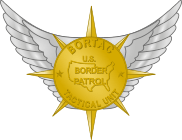BORTAC
BORTAC is an initialism for the United States "Border Patrol Tactical Unit". BORTAC is the tactical/special response arm of the United States Border Patrol.
| BORTAC | |
|---|---|
|
Badge of the BORTAC | |
| Agency overview | |
| Formed | 1984 |
| Legal personality | Governmental: Government agency |
| Jurisdictional structure | |
| Federal agency | United States |
| General nature |
|
| Operational structure | |
| Headquarters | Biggs Army Airfield, Fort Bliss in El Paso, Texas |
| Parent agency | U.S. Border Patrol |
Mission
The mission of BORTAC is "to respond to terrorist threats of all types anywhere in the world in order to protect our nation’s homeland." [1]
History
The unit was first formed in 1984 to deal with disturbances occurring within INS detention facilities, but this mission is now handled by ICE, Enforcement & Removal Operations (ERO), Special Response Teams (SRT). Since its inception BORTAC has steadily expanded its scope and mission capabilities, and is now a rapid response unit capable of executing both foreign and national level domestic operations. BORTAC members have operated in 28 countries around the world. Missions have included international training/advisory functions, counter terrorism operations, counter narcotics operations, high-risk warrant service, dignitary protection, interdiction & patrol operations, and tactical training to other U.S. agencies and military units.[1]
Organization
BORTAC headquarters is co-located with its training unit at Biggs Army Airfield in El Paso, Texas. The BORTAC training unit is currently responsible for conducting all CBP tactical team training. In addition, the unit also provides specialist training to other Federal, state and local law enforcement agencies. As part of a joint Department of State/ Department of Justice training program, BORTAC has also provided tactical team and counter narcotics training to several foreign governments police, paramilitary, tactical, drug, and specialist units, including the El Salvador National Police's Grupo de Respuesta Policial (GRP) tactical unit.
Training
Border Patrol Agents wishing to become members of BORTAC must meet the following requirements:
- Have a minimum of three years of continuous Border Patrol service in good standing
- Obtain a passing score of 90% or better on the Border Patrol Physical Efficiency Battery (PEB) & the firearms qualification course of fire (at least 324/360)
- Pass an oral interview panel conducted by current BORTAC members
- Successfully complete a BORTAC Selection Course
- Be available for extended deployment (90 days or more) anywhere anytime.
- Make proper application for consideration to HQ-BORTAC
BORTAC’s Selection and Training Course (BSTC) was designed to mirror aspects of the U.S. Special Operations Forces’ selection courses. The grueling BSTC, which may last over a month, begins with physical testing involving push-ups, sit-ups, pull-ups, a 1.5 mile run and a pistol qualification. Candidates who pass the initial testing must then complete a timed, sixmile ruck march with a weighted pack. Additional testing is performed for swimming, treading water, and drown-proofing.
The five week BORTAC basic training course is considered one of the most difficult and arduous training courses in civilian law enforcement. Qualified BP personnel may volunteer for the unit. After an initial screening process, which includes a strenuous physical fitness test, prospective BORTAC operators are scheduled to attend the next BORTAC Basic Training Session. The course covers such diverse subjects as operations planning, land navigation, patrolling, tactical tracking, rappelling and fast roping, close quarters battle (CQB), riot control techniques, defensive tactics, firearms marksmanship and air assault operations.
Equipment
BORTAC is authorized a wide range of weapons systems such as:
- Heckler & Koch P2000 pistol, in .40 S&W, with the LEM (Law Enforcement Mechanism) double-action trigger system
- Heckler & Koch USP Compact pistol in .40 S&W
- Heckler & Koch P30L LEM in .40 S&W
- HK UMP submachine gun in .40 S&W
- Remington 870 12 gauge shotgun with 14" barrel, specially modified by Scattergun Technologies
- M4A1 carbine in 5.56×45mm
- M14 rifle in .308 Winchester
- SIG Sauer P229 DAO in 9×19mm Parabellum
- Remington 700 .308 rifle
- M40 rifle XBKS .308 rifle
- M79 grenade launcher
- M203 grenade launcher
- 37 mm gas guns
- Heckler & Koch MP5 (being phased out)
- Heckler & Koch HK33A2
- Heckler & Koch HK53 A2 or A3
- Steyr SSG rifle.
Uniforms
When conducting operations BORTAC personnel normally wear OG-107 uniforms, or sage green flight suits with a subdued Border Patrol patch sewn on. Each team member is also equipped with a Kevlar ballistic helmet and a Kevlar assault vest. Boots worn by individual team members depend on the operator's personal preference and situation.
Operations

During the 1980s War on Drugs, BORTAC worked with the Drug Enforcement Administration conducting counter narcotics operations in South America during Operation Snowcap.[2]
In April 2000, the BORTAC conducted Operation “Reunion,” in which it executed a raid on a home in Miami, Florida, and safely returned Cuban refugee Elian Gonzalez to his family in Cuba.[2]
Following the World Trade Center Attack in September 2001, BORTAC personnel were sent to high-risk areas around the country to help secure against future attacks.[2]
In 2002, BORTAC worked jointly with the United States Secret Service securing sports venues at the Salt Lake City Winter Olympic Games.[2]
Recent natural disasters have vaulted BORTAC personnel into tactical relief operations (TRO) by providing hurricane relief aid to Gulf Coast residents and law enforcement support to law enforcement agencies affected by Hurricane Katrina.[2]
In December 2010, a BORTAC agent was killed while pursuing members of a gang that operated along the border of Mexico and Arizona.[3]
See also
References
External links
- Official website Fact Sheet (PDF)
- Specwar.net article
